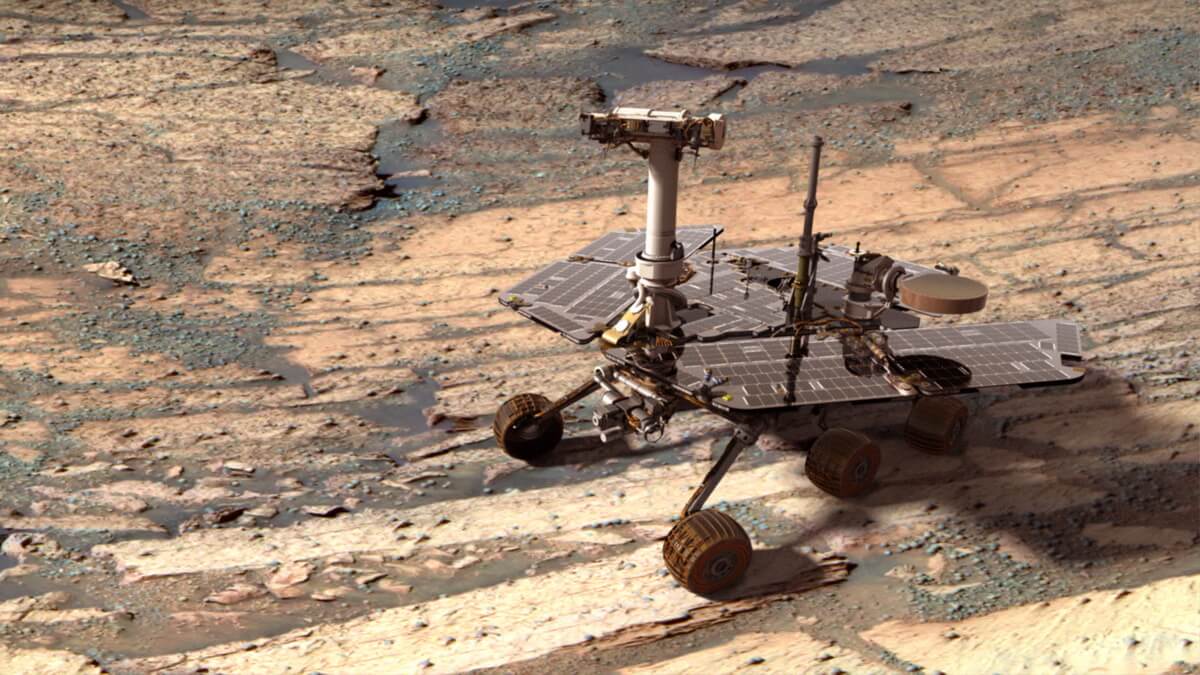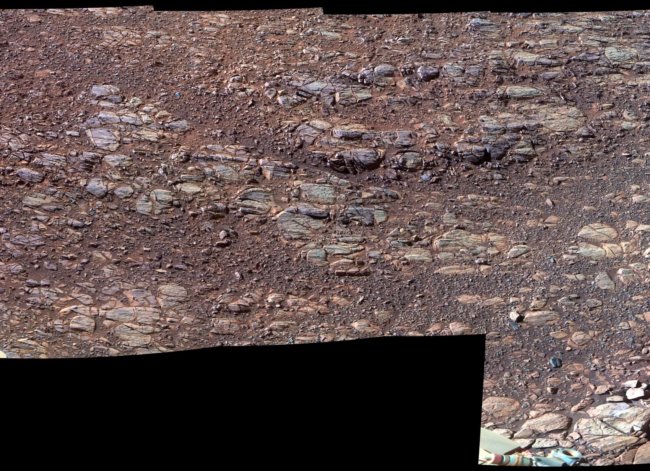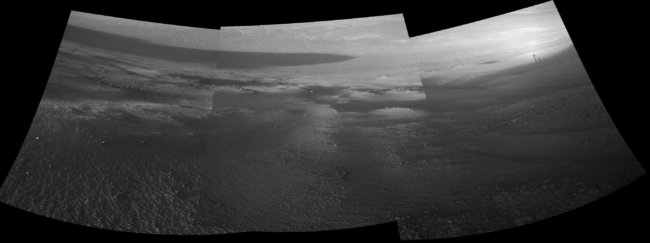
The original estimated time of work landed on the Red planet on 25 January 2004 the Mars Rover “opportunity” was about 90 earth days. However, the little robot has surpassed all expectations and is working on Mars for 13 years and 231 days, in total covering a distance of about 50 kilometers on the surface of the red planet. Opportunity remains mobile and continues to gather scientific data almost 50 times longer than its planned life span.
According to a recent report from the space Agency NASA in the framework of the “program for the exploration of Mars”, the Rover was able to survive another winter on the red planet. Despite the fact that for a little Rover this was the eighth winter on Mars, its solar panels are in pretty good condition, and the Rover will be ready for another stern test in the form of successive winter season of dust storms. It also means “opportunity” will be able to celebrate his fourteen-year-old, which will come on 25 January 2018.
A year on Mars is 686,97 earth days (or 1.88 earth years). And because the axis of Mars has a tilt of 25.19 degrees (in the Land he is slightly more than 23 degrees) on Mars, as on Earth, also occur with the changing seasons. However, they last almost two times longer than on Earth. In addition, on the red planet, of course, much colder, as the planet is farther from the Sun. The average surface temperature is -63 degrees Celsius.

Photo (with color correction) of the surface of Mars in “Valley of perseverance” (Perseverance Valley), taken by the camera Pancam of the Rover “opportunity” in October 2017
Jennifer Herman, who is the head of the group responsible for the power subsystem of the Rover “opportunity”, jet propulsion Laboratory NASA shared in a press release:
“I joined the project after the three hundredth Saul. I then said I much not happy, as “Spirit” and “opportunity” is unlikely to survive its first Martian winter. Now, however, we discuss how “opportunity” could go through the harshest part of the eighth in a row for him the winter.”
At the moment, “opportunity” and “Spirit” are in the southern hemisphere of Mars. Here during the Martian autumn and winter, the sun appears on the North side, so the solar panel macromodel should be directed to the North. In 2004 two of the six wheels on Spirit broke, and he actually got stuck in the sand, unable to maneuver. In the end, he could not deploy its solar panels to the North and did not survive the fourth Martian winter (2009).
As for “opportunity”, now it is in the “Valley of perseverance”, which is a sloping platform situated at the edge of endeavour crater. The location of the Rover allowed him to continue working during late autumn and winter. In the framework of their tasks many times he stayed for the study of certain groundwater characteristics and analysis of the breed, but at the same time, unable to get enough solar energy.

Photo of the bottom of the endeavour crater taken by the Rover “opportunity” November 11, 2017, about a week before the beginning of the eighth for Rover winter solstice
Five months ago, the Rover reached the top of the valley that stretches East on the outer rim from the Western part of the crater endeavour. Since that time, opportunity has made several stops among the most difficult areas to adjust the future direction of movement. For “opportunity” it is extremely important because the Rover has a radioisotope thermoelectric generator, which works more modern Rover “Curiosity”. Winter conditions are affecting the operation of the electric systems of both Rovers, however, the activity of “opportunity” is more heavily dependent on seasonal changes. While “Curiosity” can simply allocate the missing energy in the winter to work on other systems, “opportunity” have to adapt to a particular route in order to get enough solar energy and not get stuck.
During some past winters “opportunity” was not very well located with respect to the Sun. A during its fifth winter on Mars (2011-2012) the Rover had to spend in one place as much as 19 weeks, as there simply was not (usually he does it on solid areas), which would allow him to turn to the North, that is to deploy to the Sun its solar panel and continue. In fact, the first winter for “opportunity” proved to be very successful, as the Rover was in the southern half of the crater endeavour, where the whole area faces North.
“The need to rely only on solar energy makes us every time to worry about where “opportunity”. Whether it is turned towards the Sun. We worried about him more than “Curiosity”,” comments Herman.

Self portrait “opportunity”, made soon after covered with dust and sand solar panel of the Rover was cleaned Martian wind in March 2014
Another factor affecting energy efficiency “opportunity” are weather conditions and in particular the amount of dust contained in the atmosphere. As you may have guessed, she did not hesitate to settle on the solar panels of the Rover. Dust basically raise up a mighty wind that will result in the strongest dust storms. During the autumn and winter periods in the southern hemisphere, where there is opportunity, the sky is usually clear. Major storms in the southern hemisphere occur during spring and summer, although, fortunately, it happens not every year. This, however, can be a real problem, as it was in 2007. Storm on the planet was so powerful that even reduced the amount of “Spirit” and “opportunity” of sunlight (and therefore energy). The situation was so critical that in case both had to resort to emergency protocols, significantly reducing the volume of their activity and communication with Earth.
The amount of dust accumulating on the solar-powered Rover to the fall, can change from year to year. For example, this year’s panel proved to be stronger than dust-covered than in the previous Martian fall. But as Herman explains, the problem was solved and very successfully:
“We were worried about being on the panel this time will accumulate a lot of dust and this will be one of the worst winters for Rover. But, fortunately, the Martian wind is not only lifts, but also blows away the dust from the solar panels. Now I look at the situation more optimistically. If the batteries are “opportunity” will come clean in the same way in the future, the Rover will be able to survive and quite a strong dust storm. Last such a powerful storm was on Mars for more than 10 earth years ago.”

A photograph of one of the front wheels of the Rover “opportunity”, issued on 9 June 2004, when the Rover was inside endeavour crater
Over the next months the team “opportunity” is going to figure out one mystery. It so happened that part of the “valley of perseverance” suffered the fate of the landslide, and it literally slipped inside endeavour crater.
“We have not found any prerequisites for this. Check to see what was the cause and whether this cause water. We can get very important clues from the sediments in the lowland valleys, but right now we don’t, as the current level of the bottom has a solid base and the Rover may just get caught up in it”.
After experiencing its eighth winter on Mars, “opportunity” is in good working order and therefore will continue to perform its tasks. They include, for example, is the study of the clues that pointed to more warm and wet history of the red planet. Who knows, maybe in her endeavour crater could even be a lake filled with water.
Given the favorable weather on Mars in the coming years, we can expect that “opportunity” will continue to move forward our scientific frontiers, and its limits of endurance.
Mars Rover “opportunity” has survived eight winters on the red planet
Nikolai Khizhnyak